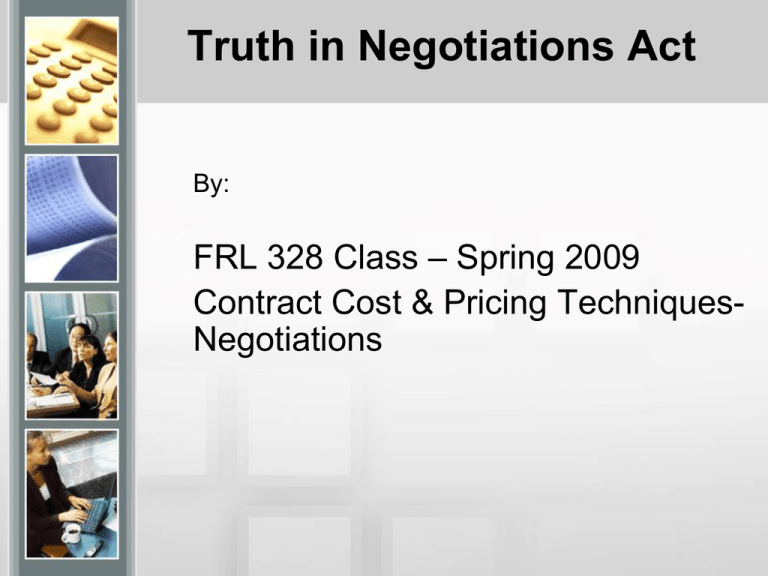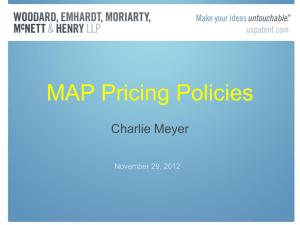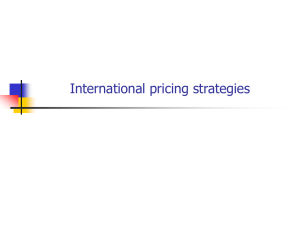
Truth in Negotiations Act
By:
FRL 328 Class – Spring 2009
Contract Cost & Pricing TechniquesNegotiations
What is “TINA”?
• Truth in Negotiations Act, aka “TINA”, was
enacted on September 10, 1962.
• Federal Law whose purpose is to protect the
Government from defective pricing when
negotiating Sole Source, Non-Competitive
Contracts with an award worth $650,000 or
more.
• Requires the contractor to submit cost or pricing
data that is certified to be Accurate, Current, and
Complete as of the date of agreement on price.
FAR 15.403-4 Requiring cost or pricing data (10 U.S.C. §2306a and
41 U.S.C. §254b).
What Purpose Does TINA Serve?
• Provides for full and fair disclosure by
contractors during the course of
contract negotiations with the
Government.
• Since it is used for non-competitive
contracts, TINA’s purpose is to protect
the Government from being “ripped off.”
What Purpose Does TINA Serve?
• Requires the contractor, and any
sub-contractors, to provide the
government with current, good faith
estimates of the costs to perform
the contract.
• Establishes a standard for
measuring “fair and reasonable”
pricing of the contract.
What Purpose Does TINA Serve?
• Provides the Government with an assurance
that the information submitted falls within a
current and reasonable time frame.
• Gives the Government the right to obtain a
remedy due to defective contract cost terms
provided that the Government relied on the
defective pricing data to their detriment.
Characteristics of TINA
• TINA is a ‘one-way’ law because the
entire burden is on the contractor to
comply with the certification of the pricing
data.
• Allows for ‘Flow Downs’:
– The Defense Contract Audit Agency, DCAA,
may contact any sub-contractors of the prime
contractor to obtain any cost data without first
notifying the prime.
The Applicability of TINA
TINA applies to the following:
•
Any negotiated contract award expected to be
$650,000 or more.
• A modification of a negotiated or sealed-bid contract
involving a price adjustment of $650,000 or more.
• The award of a subcontract totaling $650,000 or more
(if prime/higher tiered contract needs to provide cost
or pricing data).
• A modification of a subcontract involving a price
adjustment equaling $650,000 or more.
Cost and Pricing Data
•
Definition under the FAR:
- FAR 2.101
- 10 U.S.C. §2306a(i)
“All facts that a prudent buyer or seller would
reasonably expect to affect the negotiations of price
significantly. This factual information must be
accurate, complete and current as of the date of
the agreement on price, or on another date that is
agreed upon by the parties. All cost and pricing data
must be factually useful and cannot be a judgment by
the submitting party.”
Cost and Pricing Data
•
The Cost and Pricing Data
(C&PD) must be FACT based, not
judgments.
•
When data contains a mixture of
fact and judgments, the
“commingled” data may need to be
disclosed.
Cost and Pricing Data
Types of FACT based data:
1. Vendor quotations
2. Non-reoccurring costs
3. Information on changes in production methods
and in production or purchasing volume
4. Data supporting projections of business forecasts
and related operations costs
Cost and Pricing Data
Types of FACT based data (continued):
5. Unit-cost trends such as those associated with
labor efficiency
6. Make-or-Buy decisions
7. Estimated resources to attain business goals
8. Information on management decisions that
could have a significant bearing on costs.
Cost and Pricing Data
Types of JUDGMENT based data:
1. Statements of opinions on the price:
“The price should not be less than…”
“This type of material is worth more than…”
2. Estimates based on past data that cannot be
verified.
Cost and Pricing Data
• The purpose behind the Cost and Pricing
Data requirements is that all available C&PD
must be submitted and disclosed.
• Submission of cost or pricing data is a
continuous process:
1. it starts when the proposal is submitted
2. anytime before and during negotiations
3. continues during the government audit
Cost and Pricing Data
• All available C&PD must be submitted as of the
handshake date (of price/certification) or an
earlier agreed upon cutoff date which is as close
to the original price agreement date as possible.
• Contractor is not required to disclose any new
C&PD that becomes available after the
handshake date.
Cost and Pricing Data
‘Flow Downs’ to Sub-contractors:
• Sub-contractors are subjected to the same guidelines
under TINA that Prime Contractors are subjected to.
• Prime contractors are required to perform a cost analysis of
its subcontractor’s C&PD and to provide the results of the
analysis to the Government in addition to the contractor’s
C&PD submission.
• Sub-contractor C&PD must also be certified as accurate,
current, and complete.
“Christmas Tree” Doctrine
© Copyright 2009
John B. Wyatt III
All Rights Reserved
Flow Downs
U.S. Government
*The Star*
Prime Contractor
*1st Tier
Any sub-contractors
*Government can request C&PD
from any sub-contractors below
the Prime at any time.
Cost and Pricing Data
Exceptions for C&PD:
• FAR 15.403-1(a)-(b)
- there is adequate competition to prevent the
contractor for inflating prices
- price is set by statute or regulations
- the contract is for a commercial item
- a waiver has been given by the head of the agency
or head of the contracted program
- when modifying a contract or subcontract for
commercial items
Cost and Pricing Data
Exceptions for C&PD:
• FAR 15.403-2(a)
- The exercise of an option at the price
established at contract award or initial negotiation
does not require submission of cost or pricing
data.
Cost and Pricing Data
• FAR 15.480-1
- prescribes FAR clause 52.215-20/21
“REQUIREMENTS FOR COST OR PRICING
DATA”
Or
“INFORMATION OTHER THAN COST OR
PRICING DATA”
- instructs contractors to provide cost or pricing
data in accordance with FAR Table 15-2.
Duty of the Contracting Officer
• Prime contractor shall submit their C&PD to
the Contracting Officer (CO).
• When certified C&PD is not required by other
sections, the Contracting Officer may still
require submission of data other than the
C&PD.
Duty of the Contracting Officer
Contracting Officers are limited by the following
rules:
•
Reasonable limitations on requests for sales data
regarding commercial items.
•
That the officer limit, to the maximum extent practicable,
the scope of such requests to information that is in the
form regularly maintained by the offeror in normal
commercial operations.
•
The Federal Government shall not disclose that is has
received information relating to such commercial items if
these items are exempted from disclosure under section
552 of Title 5 (exceptions to the Open Meetings rule of
government agencies).
Consequences for Non-Compliance
• If the contractor submits inaccurate,
incomplete, or non-current data, the
contractor will be subject to contractual,
civil, and possible criminal liability,
including fraud.
• If pricing is found to be defective and the
Government relied on the defective data
to their detriment, this can result in the
reduction of contract price, and interests
may be levied.
Consequences for Non-Compliance
• If the contractor’s pricing is determined
and provable by the Government to be
fraudulent, then the contractor is subject
(but not limited) to the following:
1. Pay Fines
2. Debarment from other government contracts
3. Jail Time
Defenses for violations of TINA
1) Question arises as to whether the alleged
defective pricing contains “Cost and Pricing
Data” as defined by TINA?
- Statute 10USC §2306a states FACTS not judgments
between reasonable buyer and reasonable seller that they
would believe to effect price negotiations significantly.
2) Can the Government prove detrimental
reliance on the defective data?
- The Price Negotiated Memorandum (PNM) is a way to
affirmatively establish that the Government relied on the
data.
Defenses for violations of TINA
3) In cases of FRAUD allegation, the
Government must prove “Scienter,” the
specific intent to deceive.
- Defective Pricing is negligence, rather than specific intent to
deceive.
- Specific intent MUST be proven by the Government in order to
establish a prima facie case of fraud.
4)
“Price Reduction for Defective Cost or
Pricing Data” clause.
- Right of Set Off: negligent overstatements can be offset
against other negligent understatements to the degree of the
understatements but no more.
“Price Reduction for Defective Cost or Pricing
Data” clause (Right of Set Off)
• If “any price, including profit or fee… was increased by any
significant amount” because the contractor or subcontractor
submitted data “that were not current, accurate, and
complete as certified,” the contract’s “price or cost shall be
reduced accordingly.”
• The contractor’s liability is usually measured as the
difference between the actual contract price based on
defective data and the price that would have been
negotiated had current, accurate, and complete data been
disclosed.
• The FAR also provides that the government is entitled to
“recovery of any overpayment plus interest on the
payments.”
Government can obtain price
adjustments even if contractor argues…
(i) The contractor or subcontractor was a sole source
supplier.
(ii) The Contracting Officer should have known that the cost
or pricing data was defective.
(iii) Agreement was on the TOTAL cost of contract, and
does not concern the cost of each individual item procured
[FAR 15.407-1(b)(3)].
(iv) Certificate of Current Cost or Pricing data (relating to
the contract) was not submitted, but Cost or pricing data
was none the less required.
Current Issues with TINA
Time consuming in the course of contract award
periods:
• Procurement Contracting Officers (PCO) are required to
repeatedly use Cost and Pricing Data (C&PD) to determine
the fairness of the contract price.
• Potentially lengthens the firm bid period because
contractors need to gather, clarify, and certify the C&PD
while the PCO and DCAA analyzes it.
• The resulting conservatism on the PCO’s part can lead to a
risk aversion to Cost/Benefit issues and the Government
paying a substantial sum of taxpayer money in Proposal
Preparation Costs.
Current Issues with TINA
Changes and Revisions impacting TINA:
A. The Federal Acquisition Streamlining Act
(FASA) of 1994.
• The Federal Acquisition Streamlining Act (FASA) created a
hierarchical preference of what types of information could
be used by a PCO to assess “price reasonableness”:
1. Historical Data (past dealings)
2. Market and/or Catalog Price for commercial
products.
Current Issues with TINA
Changes and Revisions impacting TINA:
A. The Federal Acquisition Streamlining Act
(FASA) of 1994.
• The FASA established a “TINA WAIVER” that
precluded a requirement for cost and pricing data
if an exception applies.
Current Issues with TINA
Changes and Revisions impacting TINA:
B. Potential Impact of Federal Acquisition Reform
Act (FARA) and Information Technology
Management Reform Act (ITMRA) on TINA
• Create the need for exceptions to TINA for commercial
items based on established catalog or market prices.
• Removes the government’s right to conduct a postcontract award audit of data submitted by commercial
suppliers in that didn’t submit cost and pricing data.
Case Analysis
TINA Case
Michael W. Wynne
Secretary of the Air Force - Appellee
v.
United Technologies Corporation
Appellant
United States Court of Appeals for the Federal
Circuit
463 F.3d 1261; 2006 U.S.
Facts
Secretary of the Air Force is seeking a contracting price
reduction under the Truth in Negotiations Act on the
grounds that the contractor furnished defective cost and
pricing data on its initial proposal and Best and Final Offer
(BAFO).
Air Force seeking contract price reduction of $300 million.
The Board found that although the defective data had
caused an increase in contract price in some instances,
there were decreases in contract price in others.
Facts
The contract price reductions to which the Air
Force was entitled were exceeded by the offsets
to which United Technologies was entitled.
The Board found as a matter of fact that neither
the Defense Contract Audit Agency (DCAA), the
Air Force price analyst, the contracting officer
(CO) nor the cost panel reviewed the BAFO cost
or pricing data prior to award.
Appellant Arguments
• The Secretary argued that United Technologies furnished
defective cost and pricing data.
• The Secretary argued that it was never necessary to
establish that the Government relied upon the defective
cost or pricing data to its detriment, as it was sufficient to
establish that the contract price offered by the contractor
was calculated using the defective cost or pricing data.
• Air Force was entitled to a contract price reduction under
the Truth in Negotiations Act (TINA), 10 U.S.C. §
2306(f)(1983).
Appellee Arguments
• United Technologies argued that the
Board's inquiry as to causation should
properly focus on whether the Air Force
relied on the defective BAFO cost or
pricing data to award the contract
• to determine that the offered prices were
fair and reasonable.
Issues
• Did the contractor furnish defective cost and
pricing data that was inaccurate, incomplete,
or non-current?
• Did the government rely upon the defective
data to its detriment in agreeing to the
contract price?
• Is reliance on defective data an essential
element of a TINA claim that a contract price
was increased by defective cost or pricing
data?
Decision
• Claim was DENIED - The Board concluded that
the Air Force had not shown reliance upon the
defective cost or pricing data, and that "it failed to
show that appellant's defective BAFO cost or
pricing data caused an increase in contract price
for the base year of the contract.
Decision
• The Board found that competitive forces, rather
than the defective 1983 BAFO cost or pricing data
were relied upon to make the awards and to
exercise the options for additional purchases for
fiscal years 86-90, such that the Air Force failed to
show that appellant's defective data caused an
increase in the contract price for these years.
• Air Force had failed to meet its burden of proof, as
the claimant, of showing that the defective cost or
pricing data caused an increase in the contract
price.
Footstomps
• TINA requires that when a government contract is
expected to exceed a certain value, a contractor must
submit cost or pricing data and certify that, to the best
of his knowledge and belief, the cost or pricing data
he submitted was accurate, complete and current.
• That reliance on defective data is a necessary
element of a TINA claim was reinforced through stare
decisis by this court's decision in a precedent case,
Universal Restoration, Inc. v. United States, in which
we found that the government could not recover on its
TINA claim, even though the contract price was
calculated using defective data.
Footstomps
• In 1986, Congress considered and rejected
amendments to TINA that would have eliminated
the detrimental reliance requirement.
• Congress rejected the proposed amendment;
rather than altering TINA to create a conclusive
presumption of reliance, Congress codified the
detrimental reliance requirement as a defense to
a TINA claim.
• The government could not recover on a TINA
claim if it did not rely on the allegedly defective
cost or pricing data to its detriment.
THE END
Thank You!
Presenters (In Order of Appearance):
Valeria Melendez
Hazel Villanueva
Levi Martinez
Jaclyn Zandieh
Pano Rongakos
Nick Traboulay
Vaughn Murray
Andrew Guitierrez
Lubna Khilfeh
Marlon Price
Shane Dini
John Soh
Brian Lao
Eric Eusebio









